Architectural Regime
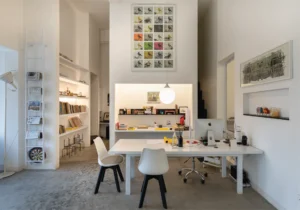
Meet Architect Salauddin Ahmed- UN HOMME AVEC DU PANACHE
Many people spend their entire lives believing that the arts and music are completely different from the hard sciences, which include physics, chemistry, engineering, and even architecture. But are they really? Enter architect Salauddin Ahmed’s Atelier Robin Architects (ARA) in Hazaribagh and marvel in the atelier’s (French for studio) all-white, lofty, and expansive interior. You will see that architecture is not truly that far from art, if at all. Walking into Salauddin’s studio was in part equivalent to getting a glimpse of his inner workings: neat, geometrically perfect, and symmetrical. Aside from the conference room, which doubles as a miniature gallery, paintings and his sketchbooks are neatly spread out in the spatial atelier, where voices echo. Salauddin, a creator as well, designed most of the fixtures and furniture in the studio. But what sets ARA’s principal architect apart from the other practitioners in the industry? His schooling is in the US. His decade-and-a-half-long stay in the US, where he studied architecture at the University of Pennsylvania, in his career-forming phase exposed him to elements of his trade that are otherwise tough to attain in Bangladesh. “I didn’t come here to settle down. I came here to try it out. During my time away from here and being involved academically, I met architect, urbanist, and architectural historian Kazi Khaleed Ashraf. He influenced me to try out my trade in Bangladesh, as there were many opportunities here when I was starting out professionally, circa 1995. Then I did discover the vastness of the architectural practice in Bangladesh,” Salauddin said, explaining why he stayed back. Then he went on to compare architecture with music, alluding to how Wolfgang Amadeus Mozart perfected music from the age of four for the love of music—not commercialisation or leaving behind a vast collection but simply a legacy. “If an architect is just building buildings at an existential level, then,” he retorted, “it’s not architecture at all. Architecture is in the conscious and the subconscious; that is the vastness of architectural practice.” As Dhaka expands northward, homogenous residential buildings are popping out everywhere. People need a place to live, yes, but these buildings are just mere cages with the most basic elements that do not remotely enhance the art of living. The schooling our young architects are receiving just deals with hyper-commercial ways of living—ways in which more buildings and apartments can be crammed into the ever-so-dwindling space of Dhaka. “The application of laws, codes, and the conduct of architecture are barely taken into consideration by the authority. All the authority cares for, almost in a military fashion, is that the buildings conform to straight lines and extremely basic designs. They are not bothered by the emotional contact that architecture bears with the art of living. Habitats that enhance the beauty of living are underscored as a passion project, and they simply don’t make a lot of money. The number of architects presently practicing is sky-high, but that number needs to be threefold as high. However, they also have the mammoth task of dictating to society how architecture works. Bangladeshi architect and urban planner Muzharul Islam embodies that ideal concept of architecture. Later on, a school was set up to learn and then unlearn Muzharul Islam to create room for fresher ideas. That has been a successful way forward, a tried and tested system through which many contemporary architects of renown have come forward. But a few exceptions cannot be an example. In a country like Bangladesh, one or two exceptions will not do,” he explained it in detail. In all sincerity, Salauddin stressed emphatically the importance of ‘averageness’. “The word average carries a negative meaning in our society. But it has been proven that a person who carries themselves with the average air is the most attractive. However, the importance of averageness is not taught at an academic level. For example, all circles don’t have to be spherical. There is beauty in a slightly elliptical and average circle as well.” This city should represent an old ‘kantha’ that is average and not gaudy, so that everyone feels a level of comfort and familiarity, thus explaining averageness. Most Dhaka residents cannot afford such luxury, which makes an average approach go hand in hand with architecture: turning an empty lot into a home. “Dhaka is growing, but as an orphan,” Salauddin said morosely. Although much opportunity is not there to salvage Dhaka anymore from its systematic ruination, “possibilities” are, however, still there. His atelier is proof of that! Walking through the mazes of what used to be the heart of the now-removed tannery industry in Hazaribagh leads to his studio. A 15-foot gate, which could almost function as a castle drawbridge, welcomes you into the imposing interior. One would be left in awe that such a magnificent studio can be set up in a relic of a retired tannery. To Salauddin, it is the will and temperament that matter. “It’s a part of my ensemble: I take immense personal struggle to show someone the possibility.” Getting back on the matter of urban design, he spoke briefly about how it is done in successful cosmopolitan cities, one in which he once resided for a while. He elaborated, “Everybody here wants a south-facing veranda. Okay, but his neighbour might be deprived of the southern wind if he takes up all the space. In New York, for example, there’s a code: your building cannot project two hours of shadow on any surface in an eight-hour window. If you cast a shadow long enough, the adjacent building will need more heating capacity in the cold and get much less sun during the day. Your design form has to respect the many constituencies of urban design. This is impossible to even imagine in Dhaka.” The long conversation ended on a beautiful note. He said, “Ninety
Read More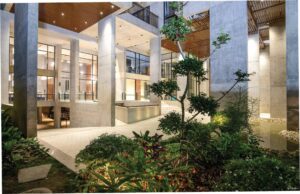
Glimpse of The Architectural Legacy of DWm4
DWm4 Architecture stands out as an innovative and visionary design studio, among the leading firms in the country. With its unwavering commitment to excellence, DWm4 has redefined the architectural landscape of Bangladesh through its creative and sustainable designs. Under the partnership of architect Mamnoon Murshed Chowdhury, architect Mahmudul Anwar Riyaad, and architect Shaoki Shamim, this renowned firm has been at the forefront of reshaping the country’s urban landscape with its innovative designs. In practice since 1995, DWm4 has been open to reshaping itself in terms of new design ideas, and also in management and operating strategies. Over the years, the practice has involved three separate and autonomously run units for architectural design [DWm4 Architects], interior design [DWm4 Intrends], and design-build projects [DWm4 Interprise]. While the founding partners, architect Mamnoon Murshed Chowdhury and architect Mahmudul Anwar Riyaad are involved in all three; the ID and Design-Build establishments have partners namely architect Daniel Haque and architect Arif Khan in chief executive and operating positions. In 2022, architect Shaoki Shamim joined DWm4 Architects as the third partner. All three architects had been members of the DWm4 team for a good number of years before joining as partners. With the younger generation coming on board, the vigour and architectural energy are strengthened through better mid-level management, enabling the practice to continuously make additions to its visions. The focus on re-structuring and evolution in DWm4 is based on the intent to produce designs of significance and relevance. While all projects follow the essential principles of being truthful to function, climate, structure, and aesthetics, they vary significantly so as not to be repetitive and predictable. For example, the architectural language is different in the office buildings like Bay’s Edgewater, Prime Bank Head Office on Gulshan Avenue, and Grameen Telecom Trust [GTT] Bhaban in Mirpur. The differences inherently are derived from site context and structural and functional prerogatives. landscaped precinct is created to bring tranquility to the context by appearing as an oasis to the pedestrians. The landscape is viewed from the interiors through the glass façade, and from the terrace formed by terminating the concrete portal on the 8th Floor, which is adjacent to the social spaces like the dining hall area, and daycare room. Another terrace facing East, adjacent to the Board Room on the 19th floor, is also a nod to the context as it provides a panoramic view of Hatirjheel. The design of Bay’s Edgewater celebrates the building’s location – accentuating the views from the interior spaces towards the sensual curves of the lake. At the same time, the layout does justice to its setting in a corner plot – separating the incoming traffic toward the more public café and gallery areas from the regular officegoers. Due to the careful attention to functional attributes, MEP, and BMS elements, after almost a decade of completion, the performance of the building is still stellar. The Prime Bank building is set deeper into the site as much as possible to be away from the maddening traffic of Gulshan Avenue. This was possible due to the site’s elongated shape. A 70-foot deep The Grameen Telecom Trust (GTT) project was designed on a partially built structure with fixed cores. By deleting one structural grid at the front and creating a water body at the place, the architects created a transcendent mediating space between the street and the double-height entry. Similarly, the very deep building floor plate was broken into two blocks by doing away with the middle parts of the floor slab by inserting a skylit atrium, which also ensured north-south airflow. The edges of the atrium are not static and shift in sections at different vertical levels. The facade is an intriguing composition of glass and concrete, creating a dynamic interplay of transparency and solidity. The patterns are inspired by organic lines of leaves and provide the building with a dynamic expression. The transparent glass sections allow natural light to enter the building, reducing the reliance on artificial lighting. About the project, architect Mahmudul Anwar Riyaad said, “We worked with the section of the building, which resembles a gallery. The ground floor lobby is dedicated to the people and space, encompassing a vast openness.” The building, designed in collaboration with architect Rashed Chowdhury reflects on people, progress, and emancipation. The field becomes more than just a patch of land; it becomes a symbol of joy, innocence, and a shared sense of community: In the typology of residential buildings, DWm4 has a large number of building projects that address the core concerns of natural light, ventilation, optimisation of space, and communicating with the context. Be it a single-family residence like the Reaz Loft in Khanpur, Narayanganj, or a multi-family building like Pohela Boishakh in Banani, Dhaka, these ideals find reflection in the designed forms. In Pohela Boishakh, the front landscape, the double-height drop-off area, and the lobby mediate with the street and creates a transition from public to private domain. The community space on the ground floor has a space that is designed as a café where residents come together and bond. The textures on the wall and floor are inspired by alpona motifs, reinforcing the spirit of Pohela Boishakh. The collaboration between the developer Signature 11 and DWm4 Architects ensured the seamless integration of architectural design and real estate development expertise, resulting in a remarkable building. The Reaz Loft stands as an incredible architectural achievement within the busy town of Narayanganj. This home on a very narrow strip of land, blends in with its surroundings and embodies modern living while paying attention to treasured memories of a special childhood field that is located in front of the loft. The elegant layout exhibits modernism with an emphasis on functionality and clear lines. As architect Riyaad explains, “Even though there was no room for horizontal deviations, we used our creativity to play with the building’s sectional elevations.” The structure stands as evidence of the designers’ keen eye for detail and commitment to creating spaces that resonate with the
Read More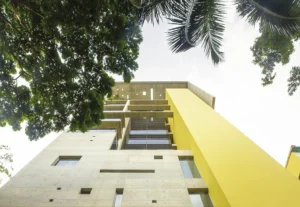
Sculpting Skyline: Unwilling contribution to the concrete jungle
Going down one of the most elite avenues of Dhaka city, the count of ones and twos will be less when it comes to the display of architecture by Mustapha Khalid Palash. Mr Palash, principal architect, and his team Vistaara Architects (Pvt.) Limited, have contributed to the new city skyline with significantly designed commercial buildings that are money-making machines for the economy. While passing by, young architects admire those works – this is quite an accomplishment for an architect, right? However, architect Mustapha Khalid Palash does not have a similar feeling. He is dissatisfied with the replacement of Dhaka’s natural landscape with man-made infrastructure, himself being a part of the contribution to the concrete ‘slum’ with added aesthetics. The nostalgic mind of this multi-talented person wanders around the city he was born in. He misses the vista of green and the landscape of Dhaka. All that visual relief has been lost in the name of fast-paced city development. The young Palash, born in the early 1960s on Baily Road, Dhaka, and later shifted to Gulshan in the mid-1990s, has a vivid scenario of life then: the environment, the lush and green of the city, and its cooling effect on the temperature in the good old days. The boom in population with unresolved planning about migration for a better lifestyle in the city is one of the main reasons for the overloaded condition in terms of size and expansion. Yet the lack of road networks and the commute system does not help much with stretching the city further north and south. Mr Palash believes decentralisation can be a solution to making these struggles better. The idea of scaling down architecture while maintaining its grandness is an old practice in this city. From the Mughal period to modern works by Louis I. Kahn and Muzharul Islam, but later it was lost somewhere in the city lines. A breathing space for the building and a gazing distance for the people are needed to observe large-scale architecture. Examples in Dhaka, as such, are the Mughal forts and palaces, the Sangshad Bhaban (parliament house), and a few others. As lifestyle developed, affordability increased. An unorganised building development started as people wanted to buy apartments over land due to a hike in prices. Hence in the last 20 years, the city became a concrete jungle from a greener jungle. Architect Palash brought back this practice in his design again. One can subconsciously understand the difference between standing in front of the Bashundhara Shopping Complex in the Panthapath area of the city, and Rangs Babylonia in Bir Uttam Mir Shawkat Sarak, on the Tejgaon-Gulshan link road. The inviting space in front of these buildings, on the street level, is the visual relief one needs while perceiving. Commercial building owners are keener towards using their well-known reputation in terms of selling spaces, and with reputation comes along building functionality and safety measures. “The architecture we design is not only for visual aesthetics that happens by default. We focus on delivery and timeline because a building is not just a space, it has a significant relation to the economy. Architecture is not just art. The basic system involves proper functional planning and the utmost safety measures for fire and structural factors. To me, architecture is like a tailored ‘coat’, where the inner lining of clothes has to be the most comfortable for the user, and the outer material has to be visually pleasing to the observer. The outer sight can differ from tastes, but the internal functionality has to be accurate,” explained Mr Palash. Architecture is a partial contributor to the destruction of this city, glorifying architecture is a cliché. He does not just design commercial buildings, but apartment buildings as well. His most well-known architecture though being on the prefaces of avenues like Gulshan is mentioned often. In all these years, he never designed a single-unit family residence, deliberately. He has done notable work in Chattogram and is currently working on a mass development project in Rajshahi. “The neo-modernism that our culture and society have gotten into has changed the social morphology to a different extent. The presence of a mobile phone is a distraction in relationships that has a social impact and even a lifestyle impact. Nowadays, apartment projects have ‘his and hers’ separate rooms, and the family living space culture is almost abandoned,” added the architect. Gulshan is already a heat island because of the excessive use of concrete, air conditioning and generator systems to support them. In addition to that the buildings are east or west facing on the avenue. Mr Palash and his team designed screening to reduce the internal effect of temperature. A few buildings even use photovoltaic glasses on the façade to produce renewable energy. “I have a hidden geometry while designing my buildings. I believe in signature, a handwritten signature, not rubber stamping.” “I have a hidden geometry while designing my buildings. I believe in signature, a handwritten signature, not rubber stamping. When I follow my geometric style, the buildings look like they are from the same house, but they are different in variation with visual expression” he mentioned. “The areas like Gulshan, Banani, Baridhara, Bashundhara R/A, Dhanmondi, and Uttara cannot be an example. The population density is much less there, and the distribution of basic commodities is also sufficient. The rest of the areas which are more organic, unsupervised, and ‘unorganised-ly’ growing are more in threat and should be taken care of” he added. Born to an artist couple, Mr Palash had exposure to art and culture since childhood. His confidence was developed in a very nurturing way by his parents, which eventually made his path of journey easy. “When I was 6, I used to assist my father with his commissioned works. If he had any works with letters, he used to draw the outline and ask me to fill it up in
Read More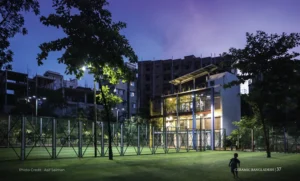
Transforming Time Embracing The Journey of designing a mother’s courtyard to a community courtyard
Architecture as a profession starts with untold responsibilities, especially from the day an architect realizes their observation about the surrounding necessities. The story of Architect Rafiq Azam starts somewhere there when the young and enthusiastic artist started his architectural school at the Bangladesh University of Engineering and Technology (BUET). Uncertain about coping with architecture, his subconscious mind always wandered towards art school. Being born and brought up in the old town and surrounded by its culture, the young Rafiq developed a lateral mindset. The results of his learning reflect on his work even after 30 years of practice as a Principal Architect with his team, Shatotto architecture for green living. From the fond memories of childhood and presently looking back to the missing pieces built the urge to refurbish the old Dhaka with a better story. But it all started with a sudden step on the realization of responsibility that he felt to hold the memories of his family, his mother, and their childhood ambiance, back when he was a third-year student struggling to survive architecture school. After the demise of his father, they wanted to rebuild their house. His mother and her affectional emptiness of giving away her memories with her husband and adapting to a new built environment made him courageous enough to start his first design project, their residence in Lalbagh, Dhaka. The only requirement from his mother was a garden and an “uthan” (courtyard), like the one they had in their old house, where she could walk around and re-live her nostalgia. The first of its kind, he designed a courtyard on the second floor of a building, gifting his mother the patch of green to cherish. Almost after 30 years, he did similar for the people of Rasulbagh, a small community in Lalbagh, Old Dhaka. He designed a communal park collaborating with the Dhaka South City Corporation, that is more like a courtyard gifted to the built community. According to Rafiq Azam, architecture is not just drawing and construction but more about a merging point of nostalgia and new memories. His inspiration for sticking to architecture, lastly, was to create for the mother, the soil, and the country. As he says, “I learned architecture from my mother.” But this journey was not easy and short. The dedicated practice and research over the last 30 years, the showcase of persistence in public domains, developed trust in people. This reliance helped him influence a struggling community like Rasulbagh to revive and celebrate life. His vast experience allowed him to execute his ideas in a way that was widely accepted and even celebrated by society. ‘Architecture’s main focus should be to improve human life, working with the environment and its habitat. It should not only be limited to accommodating the luxury of elites but that of the public as well. That is how a kinship develops. ‘Urban spaces need to improve in the name of development, not just mega infrastructures; otherwise, the quality of human life will not be enhanced. And I have always been on a mission to bring a positive change,’ expressed Rafiq Azam. Rafiq Azam’s practice has always somewhat had its roots in Old Dhaka. Earlier in his career, the wandering mind wondered about the high-thorny boundary walls of the city. He questioned the level of mistrust and hatred that people built over time. From the culture of the old town, the houses had “mer” (plinth) for people to sit and mingle, at times with mud coolers filled with water to offer the passers-by. Dhaka was a city of love and respect; it was about bonding and mingling. The answer to this subconscious dystopia was to break the boundary walls down and oppose the convention. The practice of using glass boundaries to dissolve the visual barriers between the dwellers started. “The words ‘Kancher Deyal’ from the name of Zahir Raihan drama have inspired me to think about how a boundary can be made fragile and transparent. Hence, I started implementing them in the apartment buildings by adding plantations and benches for the passers-by. I took it as an experimental process to observe the interaction of the society,” he explained. In 1998, Rafiq did his first solo art and architecture exhibition in New York. “People and critics appreciated my arts- a few even bought. However, for architecture, I mainly received praise for my ability to draw to international standards. The architecture was not something extraordinary, but rather the approach was very American. While I was coming back, I wrote in my diary, ‘I am coming back with hope and frustration. I realized the need to learn about my own country and how to incorporate that into modern architecture. Much of my foreign learning had to be unlearnt, which was tough. I felt myself to be intellectually corrupted,” recalled Rafiq Azam. With this thoughtful shift of learning and unlearning, his urban and modern architecture went through an evolution. The gathered knowledge about Bangladesh, its geographical and climatic contexts, history, and culture started influencing his architecture. He showed his clients how to reminisce their childhood, just as he did with himself while designing his residence. His western drawings started getting a layer of Bengaliness, influences of poetry and literature. The rooms were no more spaces with four walls but rather got a concept. ‘Goshsha Ghor’ (a space to release anger), ‘Bristy Ghor’ (a space to enjoy rain), ‘Swimming Pond’ with ‘Ghatla’ (rural ponds with shorelines), Jongla’ (sprawl of shrubs and bushes), all these conceptually structured his architecture in better ways. A lot of pivotal points shaped his journey. Rafiq had learned a great deal from Glen Murcutt, who spoke more about nature, history, heritage, and its association with human life. “His advice was to touch the earth lightly. Architecture is a part of nature, and the alliance between two should always be maintained,” he added. Reflections of his learnings are observed in his translation of imagination into spaces. He connected the dots without the interference of foreign
Read More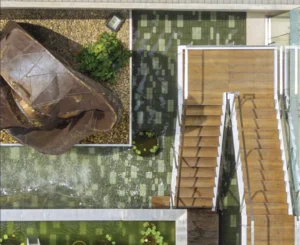
Delineating Palpable Dreams
Have you ever wondered who usually designs these beautiful buildings while crossing roads? The term architecture might not yet be practiced frequently in our society, but the changing skyline in a few parts of the city shows how architects are being acknowledged in recent years. Years back, it was mostly the peers of architects who knew about them or offered works and planned to get their building designed by an architect. People are more concerned and aware of better designs and well-functioning buildings nowadays. The dreams of architects to be in the business have somewhat taken shape. One of those dreamers is architect Mohammad Foyez Ullah, Principal and Managing Director of Volumezero-Spacezero Ltd.\ Since school times, Foyez Ullah was associated with extracurricular activities alongside studies. After completing school, he joined a cadet college, where he experienced a lot more opportunities. He was overwhelmed by the capacity of being engaged in multi-disciplinary activities and the doors they open. Performing many leadership opportunities encouraged him to be more confident and made him a better learner. He admired and idolized ex-students who topped the tire and studied architecture. The glamour of studying architecture fancied him since then, and he made his deliberate decision. He dropped biology and took a unique subject, Technical drawing, and a workshop under the industrial works to skill himself up before getting into the architectural arena. Drawing the sleek buildings out of concretes, Foyez prefers himself to be a master builder. He happily accepts to be a mason master rather than called an architect. Enjoying his work and learning more from the construction sites satisfies him more. Belongingness to the practice has made him more sensitive toward his colleagues and co-workers. A proper studio culture, where the architects collaborate, has always been his top priority. He mostly believes in investing in making a better working environment for the next generation of practicing peers and setting an example. A structured professional practice, where a career path exists, is rarely practiced in the architectural field. Looking over the benefits and well-being of the employees have mostly lacked behind. But in Volumezero, the architects tend to stick around for a longer period of time. “I have colleagues who have been working with me since the very early of this firm. They hardly shift jobs. The people who left were mostly moving abroad for higher studies. A few countable ones started their own practice. Only self-growth never seems sustainable to me. I want my fellow architects who work alongside me to be in a better state of health and mind through their working experience. We have a proper HR development with many employee benefits besides salary, and constantly try to improve over time,” shared Foyez. The overall system of the filter process of becoming a professional practicing architect has become hard. Hence the quality of the built environment is improving. The architects are better aware of the rules and regulations of the construction laws. Architecture being a sensitive discipline does not only deal with external beauty that we admire. A building is only sustainable when its usability aspects are taken care of properly. The satisfaction and well-being of the user should be the primary concern, as also the neighborhood of the associated building. With the collective responsibility that the profession owns, it should be a trustworthy practice. “Praising architecture is not a contribution to the mass people. The social impact and acknowledgment are very recent. That is because of how we individually pull it up from each end. Our focus should be as a part of society because randomly designing private projects never have any mass impact or societal improvement. Architects add value and contribute to the culture. If we explore our practices and mingle with a community of other practices, our perspective of thinking gets mended and shaped in better ways. Being social helps to be a better professional in terms of different benefits,” explained Foyez. Starting his early career as an academician, he always wanted to be a full-time practicing architect and left academia in 1998. His practice is a design and makes studio. At times they construct a few exclusive projects, and for a few, they go with the development model. This process has empowered the studio and the collaborating architects. They get the chance to visit the construction sites and learn better. The improvement is also excelling because of the era of the information age. The learning process is easy, and professionals keep themselves updated. The ones who are eager and enthusiastic to learn and develop more skills are progressing. “The upcoming generation has a lot of potential and can perform better than us if the talents get tapped correctly. Family support and upbringing are essential parts of this process of grooming. But I believe these new young lives have belongingness to Bangladesh, which is very inspiring. Big opportunities are waiting for them for a very bright future ahead. If you think I am living in a dream, I happily agree to that,” he added very hopefully. “Lead as an example” is the phase that merges with Foyez Ullah in aspects of his professional practices. His thinking process is to live by what he is preaching, and the appreciations from his fellow colleagues and externals encourage him to move forward with this motto and even get better as time goes on. To him, open-mindedness and acceptance are important as dynamics of an architect because architects depend on both critical thinking and execution. Architecture can be a noble profession to many. A lot of architects tend to judge architecture of a city, even if the city is in peril. He is more concerned with “the city as the architecture rather than the architecture of the city” Authored by Rehnuma Tasnim Sheefa
Read More
